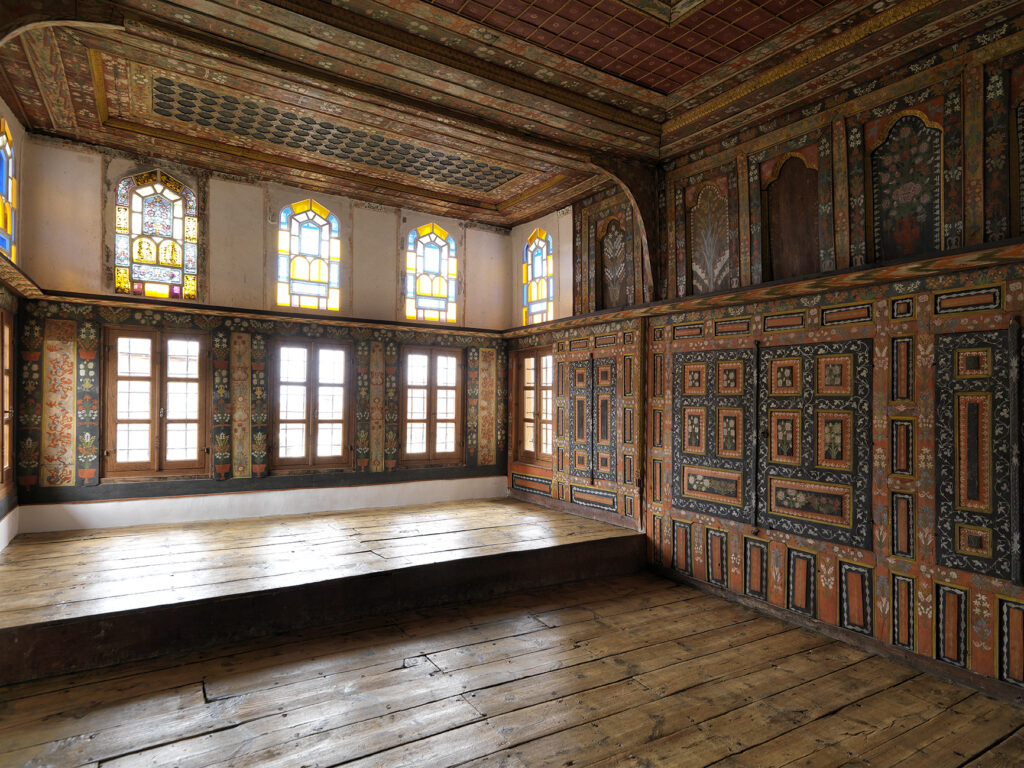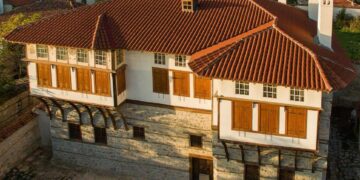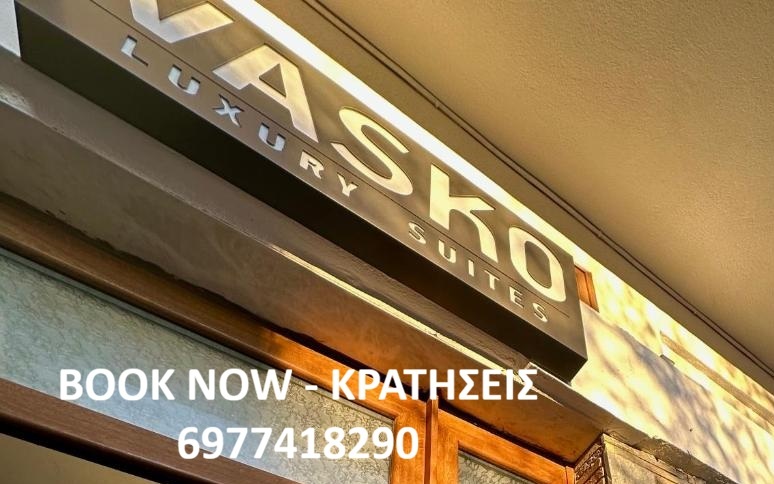Ένα από τα γνωστότερα αρχοντικά της Δυτικής Μακεδονίας με μοναδικές τοιχογραφίες και πρωτότυπη διακόσμηση.
Ακούγοντας το όνομα Σιάτιστα, το πρώτο πράγμα που μας έρχεται στο μυαλό είναι μια μικρή κωμόπολη στα ορεινά της Μακεδονίας που έχει κλειδώσει την ιστορία της σε περισσότερα από εκατό διάσπαρτα αρχοντικά.
Άλλα επισκέψιμα και άλλα σε ερειπιώδη κατάσταση, τα αρχοντικά της Σιάτιστας ταυτίστηκαν με οικογενειακές ιστορίες, πλούτη και περασμένα μεγαλεία μιας άλλης εποχής. Μέσα σε αυτό την «όαση αρχοντικών», γνωστότερο στο ευρύ κοινό είναι το αρχοντικό της Πούλκως.
Στρίβοντας στο μικρό σοκάκι στην συνοικία Γεράνεια της Σιάτιστας, το ασπροβαμμένο πετρόχτιστο αρχοντικό με τα σκουρόχρωμα σαχνισιά και τα μικρά ξύλινα παράθυρα τραβάει αμέσως τα βλέμματα. Με μία γρήγορη ματιά, το ψηλό και επιβλητικό αρχοντικό αφήνει την γλυκόπικρη αίσθηση μιας περασμένης και λιγάκι ξεχασμένης αίγλης μιας διαφορετικής εποχής. Στεκόμενοι στην πόρτα του πέτρινου μαντρότοιχου, αναρωτιέστε ποια θα ήταν άραγε αυτή η μυστηριώδης Πούλκω που για χάρη της χτίστηκε ένα τόσο μεγαλοπρεπές αρχοντικό.

Στην πραγματικότητα, το διάσημο αρχοντικό, όχι μόνο δεν χτίστηκε για χάρη της μυστηριώδους Πούλκως, αλλά έγινε ιδιοκτησία της σχεδόν δύο αιώνες μετά την θεμελίωσή του. Η ιστορία του μεγαλοπρεπούς αρχοντικού ξεκινά σχεδόν 300 χρόνια νωρίτερα, όταν ο περιπλανώμενος Έλληνας έμπορος της Οθωμανικής Αυτοκρατορίας με καταγωγή από την Σιάτιστα, Θεόδωρος Εμμανουηλίδης, αποφάσισε να χτίσει ένα τεράστιο αρχοντικό στην γενέτειρά του.
Όπως αναγράφει και η πέτρινη επιγραφή δίπλα στην κύρια είσοδο του αρχοντικού, το αρχοντικό θεμελιώθηκε το 1752 και, σύμφωνα με τις ιστορικές πηγές, προοριζόταν για κύρια κατοικία του Σιατιστινού εμπόρου, ο οποίος είχε αποκτήσει τότε διοικητικές αρμοδιότητες στην περιοχή. Σχεδιάζοντας μέχρι και την παραμικρή λεπτομέρεια, ο Εμμανουηλίδης κάλεσε τους πιο ξακουστούς τεχνίτες της περιοχής να επιμεληθούν το εσωτερικό της μεγάλης κατοικίας που προόριζε για τον εαυτό του.
Το αποτέλεσμα; Ένα υπερπολυτελές – για τα δεδομένα της εποχής – αρχοντικό με δύο πατώματα, σαχνισιά, τζάκια, βοηθητικούς χώρους, ένα τεράστιο κελάρι για αποθήκευση κρασιών και στριφογυριστές σκάλες για τους τεράστιους οντάδες.

Εκτός από την πολύπλοκη διαρρύθμιση του χώρου, αυτό που τραβά την προσοχή κάθε επισκέπτη είναι η πολυτελής εσωτερική διακόσμηση που καλύπτει κυριολεκτικά κάθε γωνιά του χώρου μην αφήνοντας καμία απολύτως επιφάνεια ακάλυπτη.
Ως πάμπλουτος έμπορος, ο Εμμανουηλίδης είχε παραγγείλει ζωγραφιστά βιτρώ, ξυλόγλυπτα ζωγραφισμένα ταβάνια, φεγγίτες, τοιχογραφίες πόλεων, μεσάντρες, ξύλινες ντουλάπες και περίτεχνες πόρτες για την διακόσμηση των τεράστιων οντάδων που είχε σχεδιάσει. Η τόσο εκλεπτυσμένη διακόσμηση σας κάνει να αναρωτιέστε πως θα ήταν το αρχοντικό, αν μέσα σε αυτούς τους χώρους βρίσκονταν και τα ντιβάνια με τις πολύχρωμες φλοκάτες και οι στρωμένοι σοφράδες με τις μακεδονίτικες πίτες και το ζεστό τσάι.

Σαν κοσμοπολίτης έμπορος του 18ου αιώνα, ο Εμμανουηλίδης ήθελε να επιδείξει τον τεράστιο πλούτο που είχε συγκεντρώσει, αλλά και να κρατήσει τις αναμνήσεις από τα ταξίδια που είχε κάνει. Επειδή, όμως, η φωτογραφία ήταν άγνωστη λέξη τότε, ο Εμμανουηλίδης προσέλαβε τους ικανότερους ζωγράφους της περιοχής να ζωγραφίσουν τις καλύτερες τοιχογραφίες πόλεων, καθώς και τα σπάνιας αξίας βιτρώ με τα οποία γέμισε τους οντάδες του αρχοντικού.
Μεταξύ άλλων, το αρχοντικό της Πούλκως είναι γνωστό για την σπάνια τοιχογραφία της Κωνσταντινούπολης – βασισμένη σε αντίστοιχη χαλκογραφία από την Μονή Βατοπαιδίου – με τα παστέλ χρώματα, τις λεπτές μαύρες γραμμές και τους ιπτάμενους δράκους, ενώ βυζαντινοί αετοί, φυτά και ζωγραφιστές γιρλάντες κοσμούν πολλές από τις εξαιρετικά σωζόμενες τοιχογραφίες που υπάρχουν σε διάφορα σημεία του αρχοντικού. Ούτε λόγος, φυσικά, για τα ζωγραφιστά τετραγωνισμένα ταβάνια και τις κάθε λογής επιφάνειες που είναι καλυμένες με περίτεχνα φυτικά μοτίβα σε αποχρώσεις πράσινου, κόκκινου και κίτρινου.

Ίσως, όμως, πιο εντυπωσιακά είναι τα σπάνια βιτρώ του αρχοντικού. Ζωγραφισμένα σε έντονα χρώματα που επιτρέπουν το λιγοστό φως της συννεφιασμένης περιοχής να διεισδύει αρμονικά στον χώρο δημιουργούν μία αίσθηση ζεστασιάς μέσα σε μία πολύχρωμη πανδαισία που γεμίζει τον χώρο. Φυτά με περίτεχνα άνθη, βυζαντινοί αετοί, θυρεοί και άλλα σύμβολα γεμίζουν τα τετραγωνισμένα βιτρώ που είναι τοποθετημένα με μαθηματική ακρίβεια ψηλά πάνω στους τοίχους.
Αν και η πολυτέλεια του αρχοντικού ξεπερνούσε κάθε φαντασία για τα δεδομένα της εποχής, η τύχη δεν ήταν με το μέρος του Εμμανουηλίδη. Η μοίρα είχε άλλα σχέδια και ο ίδιος δεν πρόλαβε να χαρεί καθόλου την πολυτελή κατοικία που ετοίμαζε, καθώς πέθανε από άγνωστο λόγο χωρίς να προλάβει να εγκαινιάσει ποτέ το σπίτι που με τόση επιμέλεια σχεδίασε από το μηδέν.
Πολύ γρήγορα, το αρχοντικό άλλαξε ιδιοκτήτη, καθώς ένας συντοπίτης του Εμμανουηλίδη και γνωστός έμπορος καπνού στην Βιέννη, ο Λάζαρος Πουλκίδης, ήθελε να προικίσει την αγαπημένη κόρη του και έψαχνε να αγοράσει για χάρη της ένα από τα καλύτερα σπίτια στην Σιάτιστα. Κάπως έτσι, ο δαιμόνιος έμπορος πλήρωσε γη και ύδωρ, για να αγοράει το έτοιμο σπίτι του Εμμανουηλίδη, και οι νέοι ιδιοκτήτες εγκαταστάθηκαν άμεσα στο μεγαλόπρεπες αρχοντικό. Μέσα στους επόμενους δύο αιώνες, το αρχοντικό περνούσε από γενιά σε γενιά μέχρι που το 1910 η περιβόητη Πούλκω – γόνος της οικογένειας Πουλκίδη – κληρονόμησε το αρχοντικό από την μητέρα της. Για κάποιον – άγνωστο μέχρι σήμερα – λόγο, η κληρονόμος Πούλκω κληροδότησε και το όνομά της στο αρχοντικό, το οποίο παραμένει μέχρι σήμερα γνωστό ως αρχοντικό της Πούλκως.
Το αρχοντικό κατοικούνταν αδιάλειπτα από τους απογόνους των ιδιοκτητών μέχρι το 1965, όταν το ελληνικό δημόσιο απαλλοτρίωσε τα περισσότερα από τα αρχοντικά της Σιάτιστας με στόχο την προστασία τους από την λαίλαπα της αντιπαροχής που τα απειλούσε με οριστική εξαφάνιση. Η απαλλοτρίωση, όμως, συνοδεύτηκε από μία πολύ αργή αποκατάσταση και το αρχοντικό κατέστη τελικά επισκέψιμο στο κοινό σχεδόν πενήντα αργότερα.
Πριν την αποκατάσταση, το αρχοντικό ήταν σε πολύ άσχημη κατάσταση. Δύο αιώνες συνεχούς κατοίκησης είχαν αφήσει για τα καλά το στίγμα τους. Οι τοιχογραφίες είχαν ξεθωριάσει και η ξύλινη διακόσμηση δεν είχε καμία σχέση με την αρχική της αίγλη, ενώ ο κήπος του αρχοντικού είχε γεμίσει βοηθητικά παραπήγματα που έθαβαν για τα καλά την επιβλητική πρόσοψη του κτιρίου. Αυτό είχε σαν αποτέλεσμα το αρχοντικό – κόσμημα να παραμείνει στην αφάνεια για πολλά χρόνια και μετά από συνεχείς αναστηλώσεις να καταστεί τελικά επισκέψιμο για το κοινό το 2017. Αν και σήμερα έχει πάψει να είναι κατοικία, το πολυτελές αρχοντικό της Πούλκως φιλοξενεί συνεχώς πολιτιστικές εκδηλώσεις και είναι ανοιχτό καθημερινά στο κοινό για περιήγηση προσφέροντας μία νοσταλγική περιήγηση σε ένα περασμένο παρελθόν.
travel.gr































